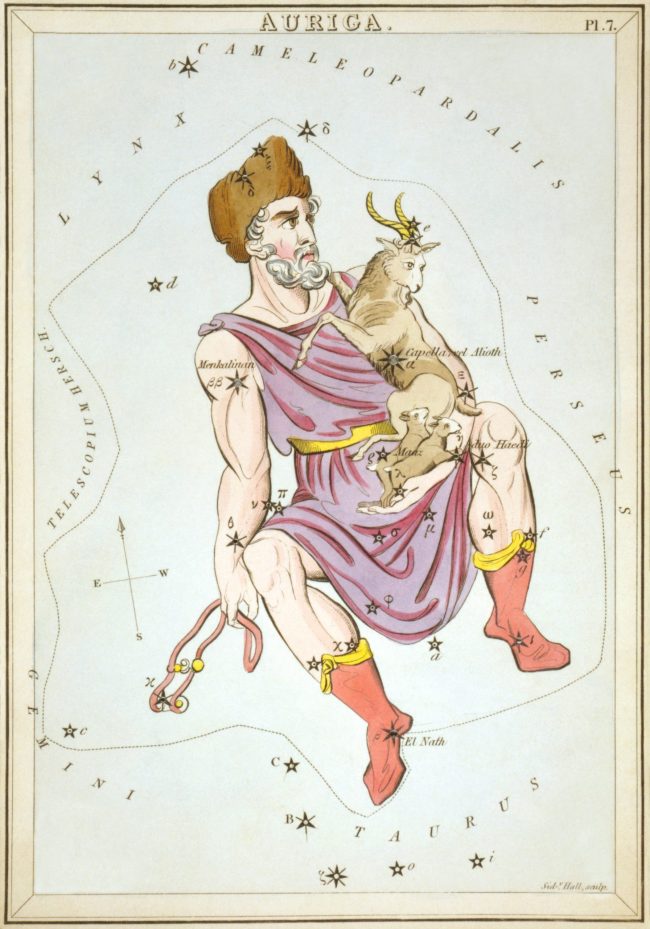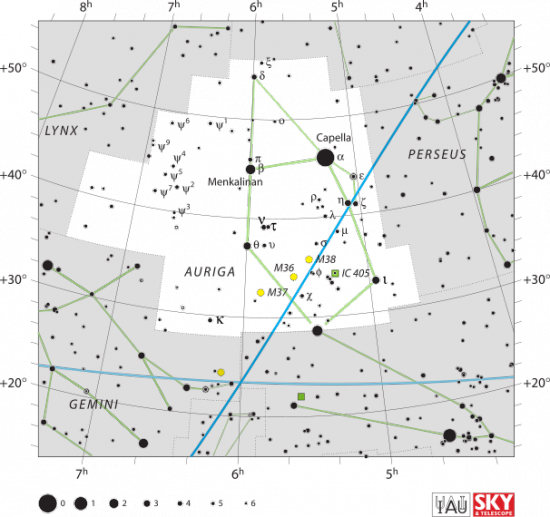Auriga has a flashy star and 3 star clusters
Auriga the Charioteer is a popular constellation for Northern Hemisphere observers in autumn, because its flashing star advertises its presence. Capella, the brightest star in Auriga, flashes red, blue and green when it’s close to the horizon and seen through a thick layer of Earth’s atmosphere. Close to Capella are a pair of stars known as The Kids, baby goats that the Charioteer carries. Auriga houses three star clusters, easy targets to hunt down with binoculars.
Auriga is a far-northern constellation. It’s close enough to the North Star that people in the northern U.S. and Canada – and similar latitudes – see it as circumpolar. In other words, they can see all or part of the constellation on any night of the year.
But some times of the year are definitely better than others. If you want to see the entirety of Auriga, start looking for the constellation and flickering Capella in Northern Hemisphere autumn. Soon you’ll be familiar with its gems and ready to go deeper by the time it moves higher and into better viewing position by winter.
The 2024 lunar calendars are here! Best Christmas gifts in the universe! Check ’em out here.

Auriga the Charioteer’s brightest star, Capella
Auriga’s brightest star, Alpha Aurigae, is a twinkling beauty named Capella. It’s a golden star, somewhat similar to our sun. In fact, if you could get some distance away from our solar system – light-years away – you might see our sun much as we see Capella. Capella is located at one corner of the constellation Auriga, marking the Charioteer’s left shoulder. By the way, Capella has the nickname the Goat Star.
Capella garners a lot of attention on autumn evenings in the Northern Hemisphere because we see it near the horizon through a thick layer of Earth’s atmosphere. The wavering atmosphere causes the light from the star to jump around, flashing bright colors of red, green and blue, making it look like an emergency vehicle parked in space. On winter evenings, Capella moves overhead near zenith and its flashiness is dampened as we look at it through a thinner layer of atmosphere.
Capella shines at a magnitude of 0.08 and is the sixth brightest star in the sky. It’s so bright because it’s nearby. Capella lies just 43 light-years away. This star marks one of the corners of the Winter Circle.
In fact, Capella is actually a pair of binary stars, both of which are yellow giant stars with small red dwarf companions.
Capella is also the closest first magnitude star to Polaris, the star currently marking our north celestial pole.

The asterism of The Kids
If you’re unsure whether you’ve identified Capella, you can always look nearby for a small triangle of stars. This triangle is an asterism, or a smaller named configuration of stars. While Capella is the Goat Star, this little triangle asterism represents The Kids. Learn more about Auriga and The Kids.
Other stars in Auriga the Charioteer
Menkalinan, the second brightest star in Auriga, marks the Charioteer’s right shoulder. This star is also fairly nearby, at a distance of 85 light-years.
Notice the star Elnath at the southern tip of Auriga. This star used to belong both to Auriga, where it was known as the heel of the Charioteer, and to the constellation Taurus, where it represented the tip of the Bull’s northern horn. In the last century, though, the International Astronomical Union decreed that this star shall belong only to Taurus!
Star clusters in Auriga the Charioteer
In a dark sky, using binoculars, you can spot some easy-to-see star clusters within Auriga: M36, M37 and M38. These Messier objects fall nearly in a line with M36 in the middle. The open star clusters have distinct personalities when viewed with magnification.
M36 bears the nickname the Pinwheel Cluster and looks reminiscent of the Pleiades. M37 is the brightest and largest of the three clusters and lies opposite the Milky Way’s galactic center, still in the plane of our galaxy but looking out to its fringes. Lastly, M38 has the nickname the Starfish Cluster. Others think this cluster looks like an X or the Greek letter Pi. What do you see?

Bottom line: From the Northern Hemisphere, look for the beautiful star Capella and its constellation Auriga the Charioteer.











